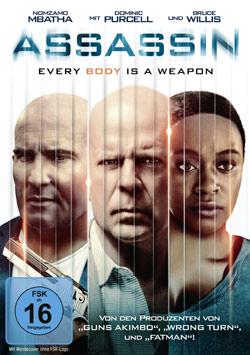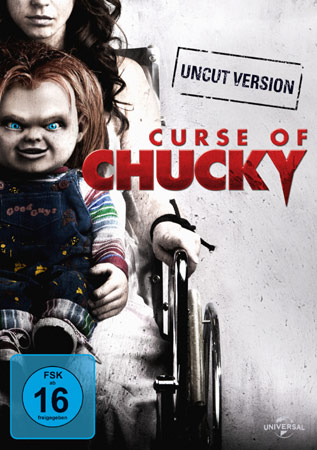
Chucky kehrt zurück in „Curse of Chucky“
Ab 24. Oktober 2013 treibt Chucky, die Mörderpuppe, wieder ihr Unwesen in euren Heimkinos! Unter der Regie des Chucky-Erfinders Don Mancini geht es in „Curse of Chucky“ nach den eher humorigen Ausflügen in „Chucky und seine Braut“ und „Chucky’s Baby“ nun wieder deutlich ernster zu. Und das Beste: Wir kommen in Deutschland dank Universal Pictures sofort in den Genuss der Unrated Fassung! Ein Grund zur Freude, den wir mit zwei Interviews zum Film abrunden wollen. Hierbei lassen wir Regisseur Don Mancini und Hauptdarstellerin Fiona Dourif zu Wort kommen…
Die Mörderpuppe ist zurück und fieser als zuvor in „Curse of Chucky“
Als Nica (Fiona Dourif) ein seltsames Paket mit einer Puppe erhält, schenkt sie diesem zuerst keine große Beachtung. Sorglos überlässt sie das niedliche Geschöpf ihrer 5-jährigen Nichte Alice, die gerade mit ihren Eltern zu Besuch ist. Kurz darauf kommt Nicas Mutter auf mysteriöse Weise ums Leben. Doch ihr Tod ist erst der Anfang einer grauenhaften Serie blutiger Angriffe: Während die Familienmitglieder in panische Angst verfallen, kommt Nica der Gedanke, dass diese Puppe alles andere als ein harmloses Kinderspielzeug ist…
Die legendäre Mörderpuppe ist zurück! Unter der Regie von Chucky-Erfinder Don Mancini richtet seine rachsüchtige Kreatur ein abscheuliches Blutbad an, das jedes Splatter-Herz höher schlagen lässt.
httpv://www.youtube.com/watch?v=lw8rBxYC1Dw
Don Mancini und sein Chucky-Musical
Filmemacher Don Mancini kreierte die zwei Fuß hohe Horrorikone Chucky, die von Brad Dourif gesprochen wird. Mancini schrieb darüber hinaus alle drei Chucky Filme der Ur-Chucky-Trilogie, die zwischen 1988 und 1991 veröffentlicht wurde. Die Filme „Die Braut von Chucky“ und „Chucky’s Baby“ produzierte er und kehrt nun als Produzent und Regisseur des neuesten Teils der Reihe, „Curse of Chucky„, zu „seinem“ Franchise zurück…
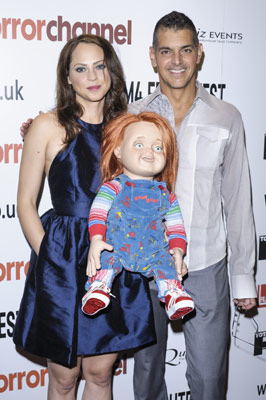
Don Mancini und Fiona Dourif im Interview über „Curse of Chucky“. Copyright aller Bilder: Universal Pictures
What were the first horror films that stuck in your memory?
The very first R-rated movie that I saw was The Omen (1976). I was about 12 or 13 and that made a huge impression on me. I think it was because I was raised Catholic, so this New Testament-based horror made a big impression on me, but also the amount of blood and gore in that film. I had never seen anything like it before. I had already been interested in filmmaking because I loved disaster movies like The Towering Inferno (1974) and The Poseidon Adventure (1972). I was very interested in special effects as a kid so when I got into horror part of my interest, initially, was figuring how the gags were done, learning about props and squibs and things like that. Then when I got a little bit older I really gravitated a lot towards Brian De Palma films, and I would say to this day my favourite horror film is Carrie (1976). I loved The Fury (1978) and Dressed to Kill (1980) and from that I discovered Dario Argento.
You liked stylish horror films…
Absolutely. My interest in the horror genre as a kid was much more those upscale movies. I was not so much into The Texas Chainsaw Massacre (1974), the down and dirty ones. I was really into the movies that melded a really beautiful aesthetic with the violence. On an aesthetic, creative level, that was very interesting to me and my primary interest in the horror genre as a filmmaker was the ability to create something very surreal.
What was the thinking behind Curse of Chucky – a franchise reboot?
I call it a tonal reboot. I think nowadays ‘reboot’ refers to something that is closer to a strict remake and this is technically a sequel to all the movies, but tonally it is a reboot, going back to the tone of the original trilogy, which is more straightforward horror. After the comedic stuff we did with Bride of Chucky (1998) and Seed of Chucky (2004), which I loved and which was certainly very successful with Bride of Chucky (1998), I wanted to change things. One of the challenges of doing a franchise with multiple films over many years is staying fresh and not wanting to make the same film over and over again. With Curse of Chucky (2013) I wanted to do something Gothic and I have never done that specific sub-genre with Chucky before, where all the action takes place in one creepy gothic mansion over the course of one stormy night. I thought it would be interesting to plug Chucky into that realm.
And what led you to create a disabled heroine?
A couple of things. Another sub-genre of thrillers that I love is what we can call the ‘handicapped heroine’, the heroine with the special vulnerability, movies like What Ever Happened to Baby Jane? (1962) and Audrey Hepburn’s Wait until Dark (1967), where she played a blind woman. There is also an Olivia De Havilland movie called Lady in a Cage (1964) where this woman is trapped in an elevator while a home invasion is happening. That was very influential for me – even just that image of the elevator that runs up the stairwell. That was part of it. The imagery of a beautiful young woman in a white nightgown in a wheelchair, I knew the iconography that that would bring would be very interesting. Also, it levels the playing field between Chucky and his quarry, because over the years a lot of times naysayers will ask, ‘Why would anybody be afraid of a two-foot doll? You could just outrun him or kick him!’ But this character cannot do that. She is literally on his level and they are forced to deal with one another in a way we have not seen in this franchise.
You cast Brad Dourif’s daughter, Fiona, as your leading lady. That’s a nice touch for fans…
Fiona Dourif auditioned along with 300 other actresses and she was so good. I resisted a little bit because it seemed almost too easy, that we should find the lead of this movie in our own back yard as it were. One of the things about Fiona Dourif that I thought made her perfect for this role though, is that I believed her in the wheelchair. It is hard to express but I saw a lot of very good actresses, but I just did not really believe them in the wheelchair. That was a real boon to the production, because she was already well versed in doing wheelies and manoeuvring it around. It is really hard to have an actress do that, because it is almost a perfect prop. It is a prop that is always there and it is very much a part of her character in the way she appears in the wheelchair, the way she operates it. Fiona Dourif had a total mastery of that. Also, she has a specific kind of beauty where I think supernatural things could happen to her; and that is not true of all actresses. It is a subtle thing but it could wreck the whole movie. Fiona Dourif played a witch on True Blood (2011) once and there is something about Fiona Dourif that occupies the supernatural realm and that worked for our film.
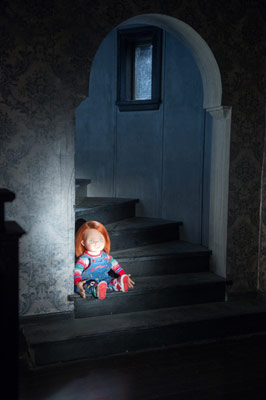
Keine Angst, Chucky will nur spielen …
You must have enjoyed shooting the poison sequence, with the roulette-wheel styled shot at the dinner table…
I was really looking forward to that. It was really fun to plan and shoot that sequence. We took an entire day to do that sequence because we all knew it was a real signature sequence for the movie. One of the occupational hazards of doing a horror franchise for the same character is that you have to constantly think up new ways to kill people and Chucky had never done that before. He had never poisoned anyone before so I thought that would be really interesting. I am glad that you picked up on the roulette-wheel imagery because that is precisely what I wanted it to look like. It was important that we were able to get to do that crane shot with the camera rising above the table. Having established that one out of six of the bowls had been poisoned, you lose track of and you do not know who is going to get the poison. It was actually a concept for a scene that I had many years ago and it is something I knew could be a great prescription for suspense. Also, because with this movie we are trying to go back to horror, it was important to create set pieces in which the simple sight of a static doll would create suspense. I knew that this scene fits that Hitchcock prescription for suspense, where he talks about the baseball metaphor – if a couple of people at the table are talking about baseball it would be utterly boring, but if you show the audience that unbeknownst to those characters there is a bomb ticking under the table, suddenly that conversation becomes fraught with tension and that was something I was trying to do in that scene.
Why do you think that the Chucky franchise has endured so well?
Part of it is Chucky himself, down to Brad Dourif’s performance. It is the efforts of the puppeteers, led by Tony Gardner. There is something delightful about Chucky. I know that when we are on set working with Chucky people are always delighted because it is just fascinating to see this doll come to life. On a dramatic level, it is a couple of things. One, there is the Freudian primal response people have to dolls coming to life. I just think there is something very powerful about that. Certainly, I did not create that; we have seen that in Twilight Zone (1959) episodes and Trilogy of Terror (1975) with Karen Black. But I realized when I wrote the first script, it had never been done in such a way that the doll was treated like a full-fledged character that had a real personality and in the end would have pages and pages of dialogue. Finally, part of it is that for young people, Chucky often goes after authority figures and I think that kids really like to see that. They like to see Chucky pervert the status quo, although in the end they like to see him get his.
Can you describe your own relationship with Chucky after all these years?
It is pure love. I was a horror fan from the time I was a little kid and if you had told my 10-year-old self that I would create a character that would become so embraced by movie audiences I would have said, ‘I don’t need to do anything else.’ I actually get that rude question from people sometimes. They say to me, ‘How come you don’t do anything other than Chucky? Why are you such a one trick pony?’ And I go, ‘It is a good trick!’
What are your plans for another instalment?
Besides the musical? Really, I am only one per cent kidding with that! One day I would love to do a Chucky musical, even on the stage. It would be awesome. In terms of movies, I definitely have an idea for the next one. Hopefully, we have not seen the last of Chucky. They will do another one with or without me but as I created it, I feel proprietary about it. I do not really want to let go just yet.
Fiona Dourif über ihr Leben mit Chucky

Fiona Dourif als Final Girl in „Curse of Chucky“
Fiona Dourif feierte ihr Schauspieldebüt in der Westernserie „Deadwood“ und tauchte danach in verschiedenen TV-Filmen und Serien auf. So spielte sie 2011 als Casey in der Vampirserie „True Blood“ mit. In „Curse of Chucky“ (2013) spielt sie die Heldin des Franchises, dessen eigentlicher „Held“ in allen sechs Chucky-Teilen von ihrem Vater Brad Dourif gesprochen wird…
What are your childhood memories of the Chucky films, growing up with your dad?
One of my earliest memories from childhood was walking into an ADR [additional dialogue recording] session where my dad was voicing Chucky being burned alive, and I did not take it well. I ran out and hid under a desk and my dad had to talk me out. He also took me to the premier of Child’s Play (1988), or at least I think he did. I may have fabricated memories about that! No, I was there and I was very scared!
Do you have a favourite film from the series?
Definitely the first one. I think the moment where Chucky comes alive in her hands is one of the most iconic moments in horror history.
Were you worried about stepping into a franchise with which your dad is so inextricably linked?
I was quite scared to do this role just because it is a family legacy and I wanted to do it justice so badly. So yes, there was a level of anxiety that I had with this role that I had not had before. But really, the most challenging aspect was keeping up the levels of intensity in like the 15th take, because the doll is so technical. There are so many people operating each aspect of his face – to get it looking perfect – that it can take a while. My intensity has to match on the last take with the first, so that is hard. Pulling myself up and down stairs without moving the lower half of my body, that was also really challenging!
What is it like playing opposite an opponent that is a doll?
Tony Gardner, who is the head puppeteer, I really, really liked. He and I got on really well. Working with a puppet is a lot easier than working with green screen. I much preferred having an actual creature interacting with me. Also, the puppeteers are actors in a way. I would look over and I would see the guys making their version of an evil Chucky face at me. Most of the time, they are doing that unconsciously. The doll can be quite technical so if the angle is not just right, the shot is unusable. It was really fun though. I had a really good time, that is the deal, even with the climax scenes being so technical. Don Mancini (Chucky creator) and I had great fun.
Are there any great moments that you and Don Mancini shared on the set of Curse of Chucky?
At the end of the shoot we had to go back and pick up a moment from the dinner scene. I am talking to Summer Howell and lighting candles and I am wheeling myself back into the other room where Chucky is going to poison the bowls of soup and I just imagined dropping this candle on myself and catching fire, and because my character was trying to impress everyone at dinner we imagined that she had just pat out the fire and carry on as if nothing had happened. Don Mancini and everyone all started laughing. It was a funny moment, but you probably had to be there! I think we were going a bit hysterical at the time!
You have played a wheelchair bound character before, in the film After the Fall (2010), right?
That was a Hallmark movie about losing the use of your body. The character I got to play was really well defined and I was able to do a lot of good research. I went to a hospital and talked to people who had lost the use of their bodies, and I learned about the upper-body exercises that they had to do. I went out in a wheelchair to a shopping mall at one point, to try and feel what that was like. Initially, being in a wheelchair in public I felt a little bit of a spectacle. That goes away. I do not know how much of that was in my mind. I did not define the character as someone who was paraplegic; she was someone who was struggling to keep her life together in regard to her family, rather than her being someone who needed taking care of.
Did your dad take you to a lot of film and TV sets when you were a kid?
The really lucky thing about being me is that I got to travel quite a bit when I was a kid. I was so fortunate. I do not think I was at the filming of Child’s Play (1988), which was in Chicago. But my dad did take me to Romania and Australia and all these cool places, so I was really lucky.
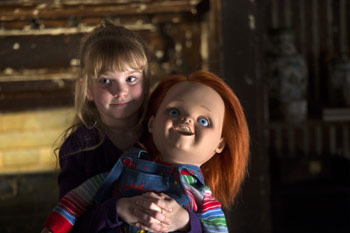
Ein mehr als garstiger Spielkamerad …
Did you always know that you wanted to act, or did that ambition evolve a little later?
It came a little later. I definitely wanted to act when I was a teenager but then in my late teens I decided that I wanted to put everything I could into self-destruction – to try and be as little like my parents as possible. I was a total brat! Later on, I got a job on David Milch’s Deadwood (2004) as a PA when I came back from Europe, having been to school in Ireland. Then David Milch offered me acting classes and offered me the chance to audition for a role. I did a little bit of work on Deadwood (2004).
How important for your career was your role in True Blood?
True Blood was a great stepping stone. It has such a cult following. [Chucky creator] Don Mancini says that it put me on the radar for horror fans. It was a prestige show and to be hired by [True Blood creator] Alan Ball was fantastic and really exciting. It is such a cult classic series and the role has got me into rooms that otherwise I would not have been in. I am really grateful for it and it was fun, too. I got to work with Fiona Shaw, for seven months, and she is one of the great living stage actresses. At the end I was still a little starstruck by her. Her Medea will go down in history!
„Curse of Chucky“ macht euer Heimkino zum blutigen Puppenhaus
Der Film erscheint am 24. Oktober 2013 von dem Label Universal Pictures auf DVD und Blu-ray und hat neben dem Hauptfilm in der ungeschnittenen Unrated Version eine ganze Menge Extras an Bord. Euch erwarten unveröffentlichte Szenen, ein Gag Reel, das Making Of von „Curse of Chucky“, ein „Storyboard Vergleich“ und die Featurettes „Chucky wird zum Leben erweckt“ und „Chuckys Vermächtnis“.



